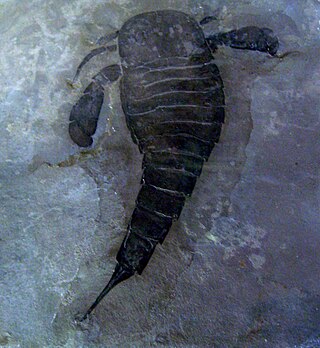
Mixopterus is a genus of eurypterid, an extinct group of aquatic arthropods. Fossils of Mixopterus have been discovered in deposits from Late Silurian age, and have been referred to several different species. Fossils have been recovered from two continents; Europe and North America.

Chasmataspidids, sometime referred to as chasmataspids, are a group of extinct chelicerate arthropods that form the order Chasmataspidida. Chasmataspidids are probably related to horseshoe crabs (Xiphosura) and/or sea scorpions (Eurypterida), with more recent studies suggest that they form a clade (Dekatriata) with Eurypterida and Arachnida. Chasmataspidids are known sporadically in the fossil record through to the mid-Devonian, with possible evidence suggesting that they were also present during the late Cambrian. Chasmataspidids are most easily recognised by having an opisthosoma divided into a wide forepart (preabdomen) and a narrow hind part (postabdomen) each comprising 4 and 9 segments respectively. There is some debate about whether they form a natural group.

Drepanopterus is an extinct genus of eurypterid and the only member of the family Drepanopteridae within the Mycteropoidea superfamily. There are currently three species assigned to the genus. The genus has historically included more species, with nine species having been associated with the genus Drepanopterus. Five of these have since been proven to be synonyms of pre-existing species, assigned to their own genera, or found to be based on insubstantial fossil data. The holotype of one species proved to be a lithic clast.

Ctenopterus is a genus of prehistoric eurypterid of the family Stylonuridae. It contains only one species, Ctenopterus cestrotus from the Early Silurian of Otisville, New York, United States.

Erieopterus is a genus of prehistoric eurypterid found in Silurian to Devonian-aged marine and freshwater strata of Europe and North America. The genus contains eight species from the Silurian to the Devonian, recovered from both North America and Europe.

Parastylonurus is a genus of prehistoric eurypterid. It is classified within the Parastylonuridae family and contains three species, P. hendersoni and P. ornatus from the Silurian of Scotland and P. sigmoidalis from the Silurian of England.

Stylonurella is a genus of prehistoric eurypterid. It is classified within the Parastylonuridae family and contains three species, S. arnoldi and S. beecheri from the Devonian of Pennsylvania, United States and S. spinipes from the Silurian of Kip Burn, Scotland.

Strobilopterus is a genus of prehistoric eurypterid of the family Strobilopteridae. The genus contains four species, two from the Devonian of Wyoming, United States, one from the Devonian of Ohio, United States and one from the Silurian of Estonia.
Tarsopterella is a genus of prehistoric eurypterid classified within the family Hardieopteridae. It contains only one species, T. scotica from the Lower Devonian of Scotland.

Stylonurus is a genus of prehistoric eurypterid of the family Stylonuridae. The genus contains three species: Stylonurus powriensis from the Devonian of Scotland, Stylonurus shaffneri from the Devonian of Pennsylvania and Stylonurus perspicillum from the Devonian of Germany.
Stylonuroides is a genus of prehistoric eurypterid. The genus is classified as a stylonurine but more precise classification has proven difficult, with the genus remaining classified as incertae sedis within the suborder. The genus contains two species, S. dolichopteroides from the Silurian of Ringerike, Norway and S. orientalis from the Devonian of Lake Shunet, Southern Siberia.

Rhenopterus is an extinct prehistoric eurypterid. Fossils of Rhenopterus have been recovered from deposits of Lower Devonian age in Germany.

Pagea is a genus of prehistoric eurypterid classified as part of the family Stylonuridae. It contains three species, all from the Devonian ; P. plotnicki from Nunavut, Canada and P. sturrocki and P. symondsii from the Old Red Sandstone of the United Kingdom. The genus is named in honor of David Page, an early worker on the fauna of the Old Red Sandstone and describer of the first Stylonurine eurypterid.

Parahughmilleria is a genus of eurypterid, an extinct group of aquatic arthropods. Fossils of Parahughmilleria have been discovered in deposits of the Devonian and Silurian age in the United States, Canada, Russia, Germany, Luxembourg and Great Britain, and have been referred to several different species. The first fossils of Parahughmilleria, discovered in the Shawangunk Mountains in 1907, were initially assigned to Eurypterus. It would not be until 54 years later when Parahughmilleria would be described.

Mycterops is a genus of prehistoric eurypterid of the family Mycteroptidae. Mycterops lived during the Carboniferous period in Europe and North America.

Dolichopteridae is an extinct family of eurypterids that lived in the Silurian and Devonian periods.

The Rhenopteridae are a family of eurypterids, an extinct group of chelicerate arthropods commonly known as "sea scorpions". The family is the only family currently contained in the superfamily Rhenopteroidea, one of four superfamilies classified as part of the suborder Stylonurina.

Eurypteroidea are an extinct superfamily of eurypterids. It contains three families and two genera of uncertain classification, Paraeurypterus and Pentlandopterus.

Brachyopterella is a genus of prehistoric eurypterid classified as part of the Rhenopteridae family. Two species, both from the Silurian period, are known; B. pentagonalis from Norway and B. ritchei from Scotland.
Leiopterella is a genus of prehistoric eurypterid of the family Rhenopteridae. It contains one species, Leiopterella tetliei, from the Early Devonian of Nunavut, Canada. The name is said to be derived from the Greek leios and pteros. The proper word for wing in ancient Greek is however pteron (πτερόν). The species name honors Dr. O. Erik Tetlie for his contributions to the study of fossil eurypterids.


















